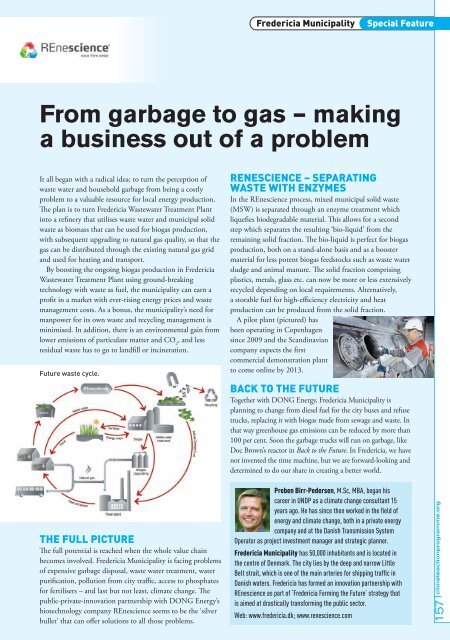Climate Action 2011-2012
You also want an ePaper? Increase the reach of your titles
YUMPU automatically turns print PDFs into web optimized ePapers that Google loves.
fredericia municipality<br />
special feature<br />
From garbage to gas – making<br />
a business out of a problem<br />
It all began with a radical idea: to turn the perception of<br />
waste water and household garbage from being a costly<br />
problem to a valuable resource for local energy production.<br />
The plan is to turn Fredericia Wastewater Treatment Plant<br />
into a refinery that utilises waste water and municipal solid<br />
waste as biomass that can be used for biogas production,<br />
with subsequent upgrading to natural gas quality, so that the<br />
gas can be distributed through the existing natural gas grid<br />
and used for heating and transport.<br />
By boosting the ongoing biogas production in Fredericia<br />
Wastewater Treatment Plant using ground-breaking<br />
technology with waste as fuel, the municipality can earn a<br />
profit in a market with ever-rising energy prices and waste<br />
management costs. As a bonus, the municipality’s need for<br />
manpower for its own waste and recycling management is<br />
minimised. In addition, there is an environmental gain from<br />
lower emissions of particulate matter and CO 2<br />
, and less<br />
residual waste has to go to landfill or incineration.<br />
Future waste cycle.<br />
renescience – separaTing<br />
wasTe wiTh enzymes<br />
In the REnescience process, mixed municipal solid waste<br />
(MSW) is separated through an enzyme treatment which<br />
liquefies biodegradable material. This allows for a second<br />
step which separates the resulting ‘bio-liquid’ from the<br />
remaining solid fraction. The bio-liquid is perfect for biogas<br />
production, both on a stand-alone basis and as a booster<br />
material for less potent biogas feedstocks such as waste water<br />
sludge and animal manure. The solid fraction comprising<br />
plastics, metals, glass etc. can now be more or less extensively<br />
recycled depending on local requirements. Alternatively,<br />
a storable fuel for high-efficiency electricity and heat<br />
production can be produced from the solid fraction.<br />
A pilot plant (pictured) has<br />
been operating in Copenhagen<br />
since 2009 and the Scandinavian<br />
company expects the first<br />
commercial demonstration plant<br />
to come online by 2013.<br />
Back To The fuTure<br />
Together with DONG Energy, Fredericia Municipality is<br />
planning to change from diesel fuel for the city buses and refuse<br />
trucks, replacing it with biogas made from sewage and waste. In<br />
that way greenhouse gas emissions can be reduced by more than<br />
100 per cent. Soon the garbage trucks will run on garbage, like<br />
Doc Brown’s reactor in Back to the Future. In Fredericia, we have<br />
not invented the time machine, but we are forward-looking and<br />
determined to do our share in creating a better world.<br />
The full picTure<br />
The full potential is reached when the whole value chain<br />
becomes involved. Fredericia Municipality is facing problems<br />
of expensive garbage disposal, waste water treatment, water<br />
purification, pollution from city traffic, access to phosphates<br />
for fertilisers – and last but not least, climate change. The<br />
public-private-innovation partnership with DONG Energy’s<br />
biotechnology company REnescience seems to be the ‘silver<br />
bullet’ that can offer solutions to all those problems.<br />
Preben Birr-Pedersen, M.Sc, MBA, began his<br />
career in UNDP as a climate change consultant 15<br />
years ago. He has since then worked in the field of<br />
energy and climate change, both in a private energy<br />
company and at the Danish Transmission System<br />
Operator as project investment manager and strategic planner.<br />
Fredericia Municipality has 50,000 inhabitants and is located in<br />
the centre of Denmark. The city lies by the deep and narrow Little<br />
Belt strait, which is one of the main arteries for shipping traffic in<br />
Danish waters. Fredericia has formed an innovation partnership with<br />
REnescience as part of ‘Fredericia Forming the Future’ strategy that<br />
is aimed at drastically transforming the public sector.<br />
Web: www.fredericia.dk; www.renescience.com<br />
157 climateactionprogramme.org












